Let me just start by saying that there’s not really a 100% perfect kind of non-toxic cookware.
There are definitely some kinds of pots and pans I recommend everyone stay away from (spoiler: it’s the traditional non-stick kind), but beyond that, the best non-toxic cookware for you comes down to your own personal needs, preferences, and budget.
So, the purpose of this guide is to help you figure out which option is the right fit for you so that you can make the switch to safer cookware. Below you’ll find a quick-reference chart summarizing the pros and cons of the different cookware materials, followed by more in-depth explanations and recommendations for some of the best non-toxic cookware brands.
The Nutshell on Non-Toxic Cookware:
- Conventional non-stick cookware (i.e. Teflon™) is made with PFAS chemicals (also known as “forever chemicals”), which are associated with a host of negative health effects, from cancer to high blood pressure to birth defects and more.
- Over the past couple of decades, brands have moved away from the two most well-known types of PFAS (PFOA and PFOS) and switched to similar chemicals that are still in the PFAS family.
- These newer chemicals are just as toxic as their predecessors. In order to avoid getting tricked by greenwashing, look for brands that are free from all PFAS chemicals, not just one or two of them.
- There is no “perfect” type of cookware. Each material has its pros and cons, and individuals will choose which type is best for them based on their own needs and preferences.
- Scroll down for a chart summarizing the different types of cookware and our recommended brands for each category!
Table of Contents
- The Nutshell on Non-Toxic Cookware:
- Should You Make the Switch to Non-Toxic Pots & Pans?
- Conventional Teflon Non-Stick Cookware (AVOID)
- “PFOA- and PFOS-Free” Cookware (AVOID)
- Safest Non-Toxic Cookware Materials
- 100% Ceramic Cookware (Best)
- Ceramic-Coated Cookware (Better)
- Cast Iron Cookware (Best)
- Carbon Steel Cookware (Best)
- Enameled Cookware (Better)
- Stainless Steel Cookware (Better)
- Copper Cookware (Better)
This article contains affiliate links, which means we may earn a commission if you decide to make a purchase. As always, all recommendations are honest.
By the way, there are a few other materials you may be wondering about, like glass, stoneware, and silicone. Since these materials are more often used for baking in the oven instead of cooking on the stovetop, we’ve omitted them from this guide and instead addressed them in our non-toxic bakeware guide.
Should You Make the Switch to Non-Toxic Pots & Pans?
I do believe switching to non-toxic cookware is relatively high on the priority list as you switch to a low-tox lifestyle. This is because of:
- Frequency of use. Most of us use our cookware multiple times a week, if not every single day or even multiple times a day.
- Ingestion. When you use toxic cookware, the toxins leach into your food, which you then ingest. In contrast, your rain jacket also most likely contains toxic PFAS, but you’re not going to eat that. (Right?!) So even though we definitely don’t want toxins in our rain jackets, I would say it’s lower on the priority list compared to cookware.
- Heat. Heat is one of the things that can increase the amount of toxins that leach out of a product. And obviously, you’re going to be heating your cookware every time you use it!
Okay, now let’s take a deeper look into the good, bad, and ugly for cookware materials…
Conventional Teflon Non-Stick Cookware (AVOID)
By now, most people are at least vaguely aware of the fact that the nonstick coating on conventional pans is made with toxic PFAS chemicals, or “forever chemicals” as they are nicknamed. Despite that fact, this Teflon™ style of cookware is still the most widely used, in part because it requires very little maintenance and you can get it for cheap.
Even though Teflon™ is the most recognizable brand name for nonstick cookware, nearly all of the conventional non-stick pans you find at stores like Amazon or Walmart are made with these same harmful chemicals (even the ones that say things like “PFOA-Free”! But we’ll get to that in a minute.)
We won’t spend too much time talking about how toxic PFAS chemicals are, but here’s an overview:
- PFAS stands for per- and polyfluoroalkyl substances. Sometimes, PFAS are referred to as PFCs instead (which stands for per- and polyfluoroalkyl chemicals).
- PFAS is not one chemical, but rather a large class of chemicals which includes more than 9,000 different varieties! PFAS chemicals are man-made and they are creating new kinds all the time.
- The most well-researched PFAS varieties include PFOA and PFOS, but other names you may have heard of include GenX, PFNA, PFTE, and PFHxS.
- PFAS have earned the nickname “forever chemicals” because they don’t easily break down in our bodies or the environment… Instead, they just keep building up over time. (Recently, researchers may have actually found a way to break down PFAS, but it’s still early so we will have to wait and see how this “pans” out!)
- In addition to non-stick cookware, PFAS are found in all kinds of other products, including food packaging, water-resistant clothing, stain-resistant furniture, and more. PFAS are also widely used in manufacturing of all kinds, which is one of the big ways these toxic chemicals get into our waterways and soil.
- There are all kinds of negative health effects associated with PFAS exposure, including cancer, infertility, high cholesterol, high blood pressure, thyroid dysfunction, ulcerative colitis, immune deficiencies, and more.
- In a true example of the canary in the coal mine metaphor, there is a phenomenon known as “Teflon toxitosis,” in which bird owners use PFAS-laden cookware that releases invisible toxic fumes, leading to severe illness or even death for their pet birds.
It’s also important to note that as of right now, there is very little regulation on PFAS chemicals. Only two kinds of PFAS (PFOA and PFOS) have been largely phased out in the U.S. for food contact materials, but this has only been a voluntary phase-out, not a legal one.
PFOA and PFOS have been added to the CA Prop 65 list, but this does not ban the use of these ingredients; it merely requires that products with over a certain amount of them have a warning label (if they’re sold to the state of California).
There is also currently no legal requirement for companies to disclose whether or not their products contain PFAS. Some brands will voluntarily share this information, but that’s mostly just because of consumer pressure, not because they have to.
The good news, however, is that after decades of scientists and citizens sounding the alarm, the tide is finally starting to turn. California, for example, recently passed legislation to phase PFAS out of clothing and textiles. The E.U. is currently considering a comprehensive ban as well.
To learn more, I highly recommend the movie Dark Waters, the documentary The Devil We Know, and the book they are both based on, Exposure by Robert Bilott. The story takes you through the poisoning of a West Virginia town by the makers of Teflon (DuPont, now called Chemours). It’s interesting, but maddening!
“PFOA- and PFOS-Free” Cookware (AVOID)
As PFOS and PFOA were largely phased out of products in the U.S., they were replaced with other chemicals in the PFAS family. These ones have names like PFHxS, PFNA, and GenX. Even though at first they were said to be safer (in part because they just weren’t studied as much), we now know that they’re not.
Much of this newer generation of “PFOA-Free” and “PFOS-Free” nonstick cookware is made using polytetrafluoroethylene, or PTFE. Without getting too much into the science of it, PTFE is a precursor ingredient for the non-toxic coating on these pots and pans… But all you really need to know is that it’s just a different kind of polyfluoroalkyl substance that’s in the same family as PFOA, PFOS, GenX, etc.
How to Spot Greenwashing in Cookware
There’s a LOT of greenwashing in today’s world of non-stick cookware. When I type “cookware” into Amazon, I see a lot of brands using terms like “PFOA-free” in their product titles… But don’t be fooled! Just because you see one of these claims does NOT mean these pots and pans are free from all PFAS.
Here are some basic rules to follow to decrease your chance of getting duped by greenwashing:
1. Look for cookware that’s free from ALL PFAS (including PTFE).
Don’t fall for the “PFOA-Free” and “PFOS-Free” claims. Look for cookware that is free from all PFAS.
2. Look for cookware that’s been tested and verified against Prop 65 guidelines.
A California Prop 65 label is one way to look for brands that have been tested to be free (or almost free) from heavy metals such as lead and cadmium, as well as certain PFAS.
3. Look for as much transparency and third-party testing as possible.
Ideally, you’ll want to look for brands that not only share their ingredient information with customers, but also provide testing to back it up. (It’s not always possible to get thorough and updated info though, to be honest! So just keep in mind that sometimes you have to make the best decision made on the information you have.)
When Worn-Out Cookware Becomes Toxic Cookware
One more thing to keep in mind about non-toxic cookware is that with many kinds of materials, the cookware can become more toxic as it becomes scratched and damaged. For example, ceramic-coated pans can begin leaching aluminum if the metal core becomes exposed. Similarly, copper cookware can become toxic if/when the tin lining wears down.
This is why it’s important to become familiar with best practices when it comes to using, caring for, and cleaning your cookware, no matter which material you choose.
Safest Non-Toxic Cookware Materials
Now, let’s get on to the best kinds of non-toxic cookware! We’ve sorted these types into “better” and “best” and included the reasons for each rating so that you can make the best decision for you and your family.
100% Ceramic Cookware (Best)
You will come across both 100% ceramic and ceramic-coated cookware, and it’s important to know that there is a difference.
100% ceramic cookware is made entirely out of materials like sand, clay, quartz, and other minerals, whereas ceramic-coated pans have a metal core and then a ceramic coating on top of it. (We’ll get more into ceramic-coated cookware next.)
It’s important to note that ceramic is not a material; it’s a process. So the quality and safety of 100% ceramic pots and pans does depend on sourcing and manufacturing processes.
High-quality 100% pure ceramic cookware is one of the best options for non-toxic cookware. When well made, it’s not going to leach toxins, it’s got great heat conduction, and when you take care of it, it can last a long time. It doesn’t degrade and break down the way ceramic-coated cookware can.
100% ceramic is also the best option for cooking acidic foods, such as tomato sauce. (Other options such as cast iron, stainless steel, and enameled cookware can increase metal leaching when cooking acidic foods.)
The downsides of 100% ceramic cookware is that they are usually heavy, and they are also more breakable compared to other types of pots and pans. Another potentially downside is that it’s not naturally non-stick. Like cast iron, you have to add proper oil and heat in order to make it non-stick.
Our Pick: Xtrema
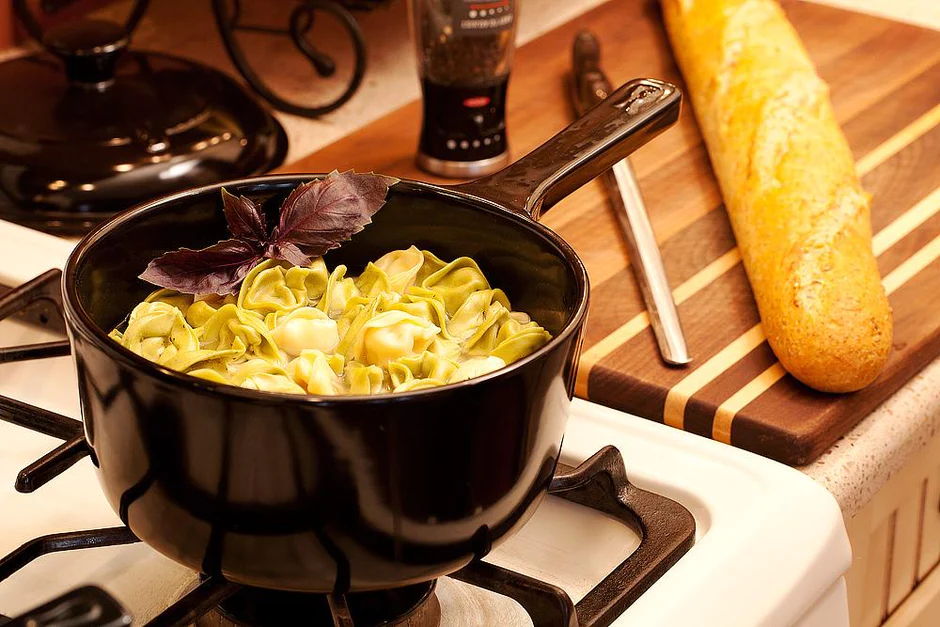
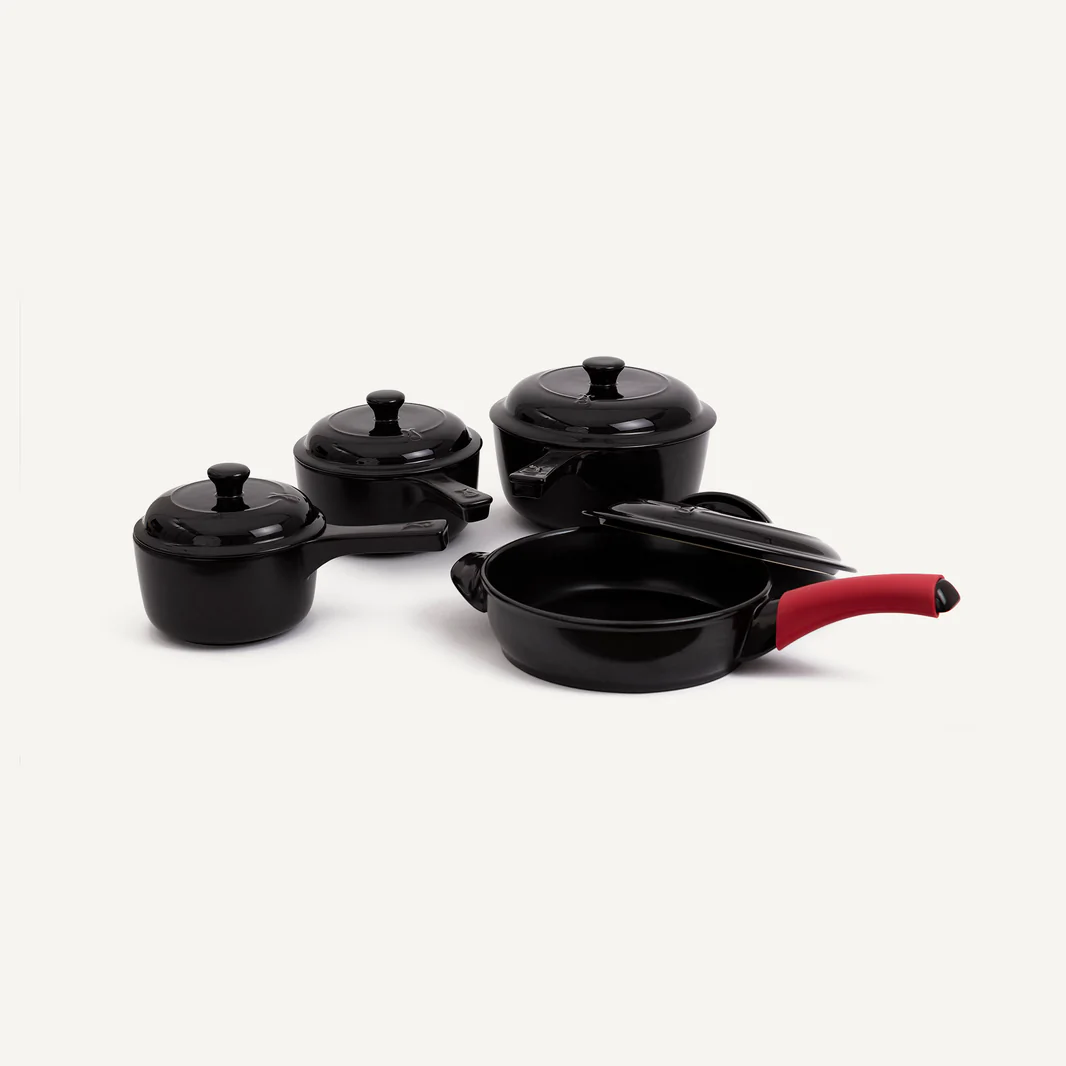
Carries: Cookware (pots & pans, woks, dutch ovens, grills, and more); Bakeware (muffins, loaf, pie pans); Teaware (kettles, mugs);
Price Range: $50 (signature skillet) – $600 (12-piece set)
Xtrema is definitely one of the safest cookware brands available. It’s made out of clay, water, natural minerals, and oxides, and fired at very high temperatures in order to ensure proper stabilization and prevent any leaching. Each piece is made by hand, too, not by machines.
They actually test every shipment for extractable lead and cadmium in accordance with California Prop 65. They have passed Prop 65 standards for lead and cadmium for the past 15 years, and they even make these results available on their website for consumers to check out.
They even went a step further and tested their unglazed pans to make sure that even if the glaze on your cookware gets damaged over time, you’re still safe. I think that’s pretty cool.
Xtrema also offers some other perks like a 40-day trial and a 10-year limited warranty. For instructions on how to care for your Xtrema to get the non-stick feature, check out their Use & Care Guide. Xtrema is technically dishwasher safe, but we recommend hand-washing if possible.
Emile Henry is another brand that makes 100% ceramic cookware.
Ceramic-Coated Cookware (Better)
This is perhaps the most frustrating category of cookware in my opinion. Ceramic-coated pots and pans have faced some controversy (like when GreenPan was sued for greenwashing), and there are definitely some transparency issues across the board. So while I am not necessarily eager to recommend ceramic-coated cookware, I do believe they are a much better option than cookware that uses any PFAS chemicals.
Brands in the ceramic-coated category include Caraway, GreenPan, and Our Place. These are beautiful, trendy, and easy-to-use brands that have become very popular in recent years with their large marketing budgets.
As mentioned above, ceramic-coated pans differ from 100% ceramic pans because they are made with a metal core (usually aluminum, but sometimes stainless steel). Then they are wrapped in a ceramic outer layer, which consists of a “sol-gel” solution.
Let’s talk about the inner core first. Most of the ceramic nonstick coated cookware you’ll come across are made with aluminum cores (including Caraway, GreenPan, and Our Place). If your pots and pans get scratched over time and expose the aluminum underneath, they could start leaching aluminum, a neurotoxin that’s associated with Alzheimer’s.
This means you should take good care of them, don’t use metal utensils on them, and then consider getting rid of them if/when the coating gets scratched or starts to wear off.
Now let’s talk about the ceramic coating and nanoparticles…
What’s the Deal with Nanoparticles?
As mentioned, the ceramic coating consists of a “sol-gel” silica-based material that gets sprayed onto the pots and pans. (Sometimes this sol-gel solution has a fancy branded name. GreenPan, for example, uses Thermolon™, which is just their version of the sol-gel solution.) This is where the main controversy comes into play.
There are a three main concerns about the sol-gel:
- Nanoparticles
- PTFE / Other PFAS
- Other toxicants
NanoparticlesThe sol-gel used may or may not contain nanosized particles of titanium dioxide and/or silicon dioxide. (Titanium dioxide nanoparticles are also used in other products like sunscreen and makeup powders.)
Titanium dioxide can be acutely toxic and/or carcinogenic, but it depends on the size of the particles as well as the route of ingestion (for example, inhalation versus skin absorption). There also just isn’t a ton of data yet about titanium dioxide nanoparticles, so unfortunately, the verdict is kinda still out on this. I will be keeping my eye on it!
Some ceramic-coated cookware brands may contain these nanoparticles and others don’t. We’ve reached out to those popular brands mentioned above to ask for more info about nanoparticles and included their answers below.
The good news is that these nanoparticles are much less likely to leach if your pots and pans are not scratched/damaged and if you keep the heat under 500 °C (932 °F), which is pretty hot.
Also, you do not have to worry about nanoparticles in 100% ceramic cookware.
PTFE & Other PFAS
According to the sol-gel patent, the material CAN contain PTFE (a kind of PFAS). So if you do get a ceramic-coated pan that uses sol-gel, you’ll want to make sure it’s explicitly free from PTFE and all PFAS. Even better if they can provide third-party testing to verify.
The Ecology Center actually tested GreenPan and found that it was indeed free from PTFE and all other PFAS. Caraway provided us with third-party test results showing PTFE was non-detectable in their pans. Great Jones did not share third-party test results, but they did tell us that their ceramic coating is NOT completely free from PTFE and/or PFOS.
Other Toxicants? (And the Green Pan Lawsuit)
The last question has to do with what else may be in sol-gel, in addition to the silica base. For example, in a 2019 class-action lawsuit, GreenPan was accused of containing potentially toxic chemicals such as tetraethoxysilane, methyltrimethoxysilane, and potassium titanate, all of which can be irritating to the eyes, skin, and respiratory tract. GreenPan was essentially accused of greenwashing, as they made claims of being “completely toxin-free” and using other similar jargon, when that maybe wasn’t entirely the case.
To save some space here, I’m going to write a separate article about my thoughts on this lawsuit (stay tuned!), but in short: it doesn’t really change my perspective on GreenPan (and other ceramic-coated cookware). I still think they are not the best option, but still much safer than any of the alternatives that contain PFAS.
Ceramic-Coated Cookware Pros & Cons
The biggest upsides to ceramic-coated cookware are that they are lightweight and super easy to use. Unlike with something like cast iron or 100% ceramic, they don’t require any seasoning to make and keep them non-stick. They’re very easy to wash, too.
Essentially, they feel very much like conventional non-stick (Teflon) pans. This is one of the reasons why I feel okay recommending ceramic-coated brands such as Caraway. If you just want something that’s super easy to use, I can’t really blame you. And even if they aren’t perfect, I would much rather you use them instead of PFAS-laden pots and pans.
The biggest downsides to ceramic-coated pans are that they are kind of expensive and they don’t last very long. They tend to scratch easily and they usually only last a couple of years. (A cast iron skillet, on the other hand, will last you a lifetime!) Not only is that not a great investment, but it’s also pretty wasteful from an environmental standpoint.
Some ceramic nonstick cookware is oven-safe and some is not, so make sure you check the specific brand’s website before putting it in the oven. Also, some brands say they are dishwasher safe and some you have to hand wash. (However, we recommend hand-washing all ceramic-coated pans to make the nonstick coatings last longer.)
Our Pick: Our Place
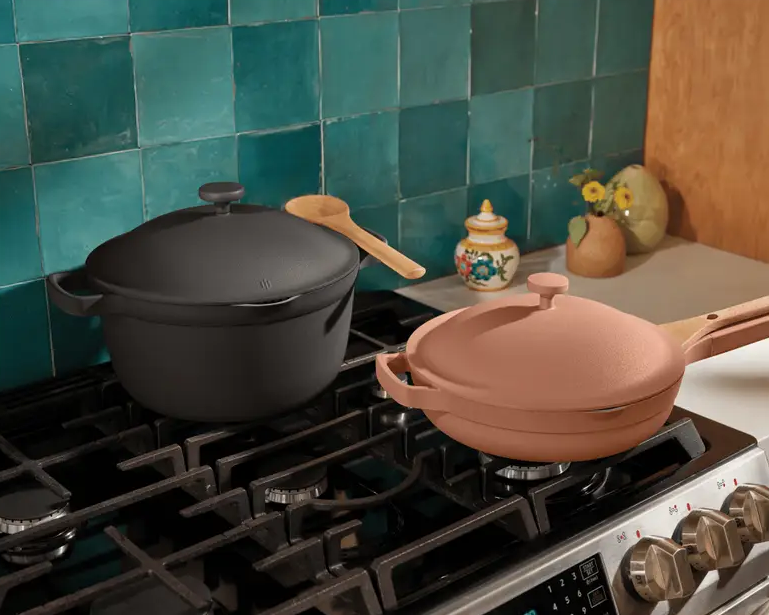
Carries: Cookware (pots and pans); Bakeware (loaf pan, baking sheet, casserole dish); Dinnerware (plates, bowls, etc.); Other accessories
Price Range: $60 (Tiny Always Pan) – $310 (Home Cook Duo Set)
Although Our Place’s sol-gel formulation is “proprietary” information (just like the rest of the ceramic-coated brands), they state that it’s free of nanoparticles and meets all of the CA Prop 65 limitations for heavy metals like lead and cadmium.
Another reason why Our Place got our top pick in this category is because of its versatility. The “Always Pan” and “Perfect Pot” are their two flagship pieces that are meant to replace the traditional full set of cookware. Not only does this make the cookware a bit more affordable as a whole, but it also helps cut down on the waste problem that comes with ceramic-coated cookware.
More ceramic-coated brands to check out:
- GreenPan (They say their Thermolon sol-gel is free from nanoparticles. They did not share third-party testing with us, but The Ecology Center did their own tests and did not find any PFAS, lead, or cadmium.)
- Caraway (They use silicon dioxide instead of titanium dioxide, but it’s not free from nanoparticles. They did, however, share their third-party testing for PFAS, Prop 65, metal leaching, and PTFE. You can check out our full Caraway bakeware review here.)
Cast Iron Cookware (Best)
I personally love cast iron. We have a small and a large cast iron skillet and they are definitely what what I use most often for cooking.
Cast iron is very versatile—you can use it to cook, bake, fry, sauté, etc. It’s really good dispersing heat evenly throughout the pan. It can also last a really long time—generations if you take care of it! It’s also great to use in the oven as well.
Cast iron is one of the safest cookware options. The only people who should consider NOT using cast iron are those who have too much iron in their system already. On the flip side, it can actually be a great option for those who are iron-deficient (which is a lot of people!).
The primary downsides to cast iron is that it’s heavy and there is a learning curve to using it. It’s weight may not be ideal for elderly folks or those with certain disabilities.
Cast iron is not inherently non-stick and requires seasoning in order to create a nonstick surface. (Many brands come pre-seasoned these days, which definitely takes it easier for you.)
It also needs to be cleaned a little bit differently than the conventional nonstick pan you’re used to. To be honest, though, it’s really not that hard! You can check out these directions from Lodge to learn how to use and care for it. (Cast iron is not dishwasher safe.)
A bonus is that almost all US-based cast iron brands are actually manufactured in the U.S. as well (which can’t always be said about other types of cookware).
Our Pick: Lodge

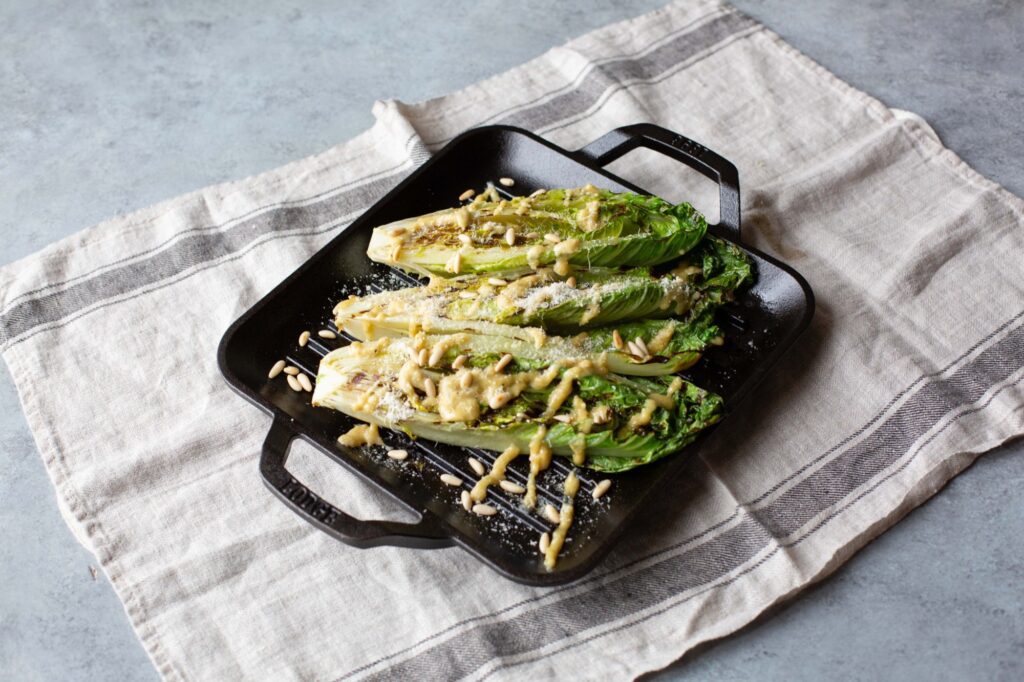
Carries: Skillets, grills, pizza pans, dutch ovens, bakeware, accessories
Price Range: $15 (small skillet) – $1,999 (19-piece set)
One of the reasons Lodge gets our pick for the best cast iron cookware is because of how affordable they are. This is one of the best options for cookware that is both non-toxic AND available at an accessible price point. They’re also pretty easy to find in big box stores if you want to pick one out in person.
Plus, Lodge consistently takes the prize in performance by cooks comparing different cast iron brands.
The history of the Lodge company is pretty cool too: it started in all the way back in 1877 and is still to the day a (fifth-generation!) family-owned company. It’s got several sustainability initiatives in place as well. They have energy-reduction measures in place, their facility operates as a Zero Hazardous Waste Foundry, they recycle their foundry sand, and they do extra stuff like plant trees.
Shop Lodge at LodgeCastIron.com, Target, or Williams Sonoma
Other cast iron companies to check out are:
Carbon Steel Cookware (Best)
Carbon steel cookware is much loved by chefs—it’s great for stir-frying and sautéing!
Carbon steel is kind of similar to cast iron, but much lighter weight. These pans do require seasoning like cast iron pans do. They’re also great at conducting heat.
Compared to stainless steel, carbon steel can tolerate higher temperatures, but are more prone to rust and require a little extra care than stainless steel does (for example, they are not dishwasher-safe and should be hand-washed).
Carbon steel cookware is generally a great non-toxic cookware option, but you’ll want to careful because some carbon steel pans come with a *mystery* non-stick coating (which might use PFAS). You’ll either want to get a non-seasoned carbon steel skillet and season it yourself, or you’ll want to get ones that’s only pre-seasoned with a natural vegetable oil.
Our Pick: de Buyer

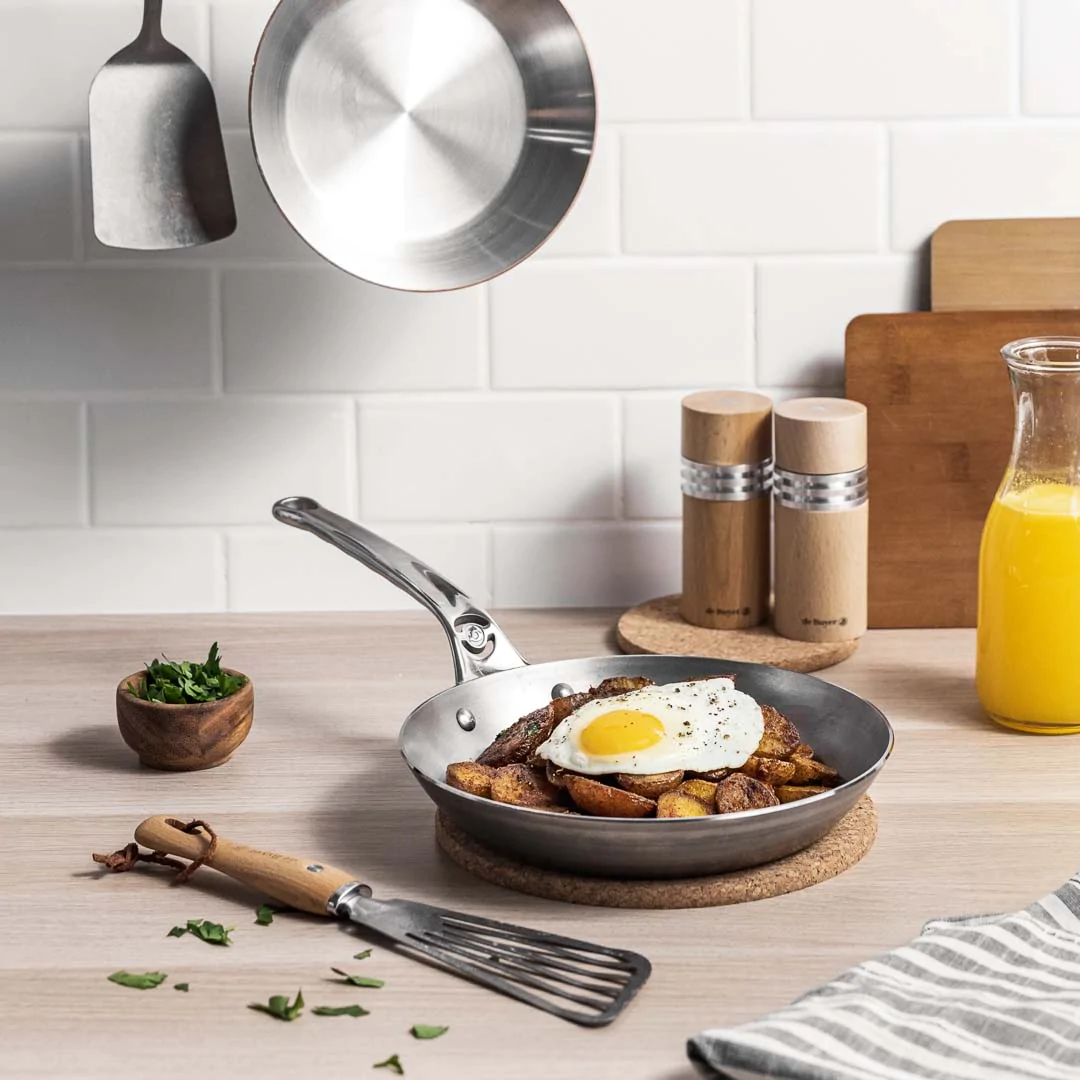
Carries: Various sizes & shapes of pans (wok, fry pan, tortilla pan, etc.)
Price Range: $25 (crepe & tortilla pan) – $215 (2-piece set)
de Buyer probably has the largest collection of carbon steel pans. The company has been around since 1830 and their pans are made in France.
Their Mineral B and Mineral B Pro lines are the best: these pans are protected with beeswax which is not only natural and healthy, but it helps prevent rust. (Note that the beeswax is a protective layer, but it’s not considered seasoning, so you still have to season it yourself.)
(Note that de Buyer also has a nonstick cookware line that we do NOT recommend, as it is not completely PFAS-free.)
Other brands that carry carbon steel include:
Enameled Cookware (Better)
Enameled cookware can mean several different things. The “enamel” part refers to the outer coating on the cookware, but the inside can be made of cast iron or stainless steel. The most common type of enameled cookware is the cast iron enameled dutch oven, like those from the well-known brand, Le Creuset.
Enameled cast iron has many of the same features as cast iron, but offers a non-stick option without the need to season.
The main concern with enameled cookware is that they can contain trace amounts of heavy metals, such as lead and cadmium. I’ve come across a couple of bloggers who have tested their own Le Creuset pans and have found trace amounts of these metals. However, these tests have limitations (and they say as much). What would be ideal is if the companies themselves did regular third-party testing across their entire collection, but we haven’t been able to find a company that actually does that yet.
Some kind of good news here is that heavy metals in this type of cookware isn’t nearly as much of a concern as it used to be. Back before the 1970s, they used to intentionally add lead to colored cookware, bakeware, dishes, glasses, but that’s not allowed anymore. (Nowadays, lead/other heavy metals would be a contaminate, which is still not great, but at least means there’s far less of it.)
This possibility of heavy metal contamination is why enameled cookware is in the “better” category and not the “best.”
If you decide you want to use enameled cast iron but want to play it on the safer side, try to choose one that’s not colored, or at least avoid red and go for a lighter color like cream or white.
Our Pick: Le Creuset
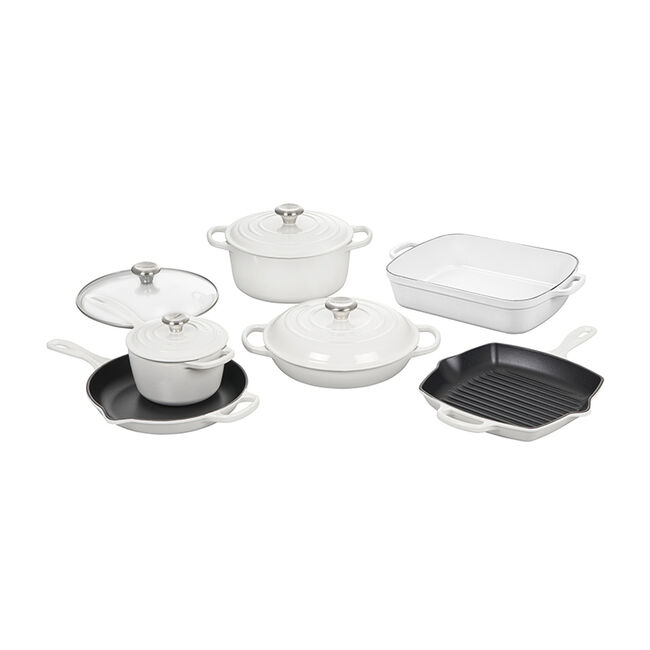

Carries: Dutch ovens, skillets, sauce pots, stockpots, griddles, and more.
Price Range: $120 (skillet) – $2,200 (11-piece “ultimate” set)
Le Creuset definitely has the most choices, which is the main reason it gets our top pick for enameled cast iron cookware. They’ve even got unique options like Harry Potter themed cookware—cool!
Le Creuset has been around since 1925 and their products are still crafted by hand in France. They’re pretty durable and should last decades.
Note that Le Creuset does have a “Nonstick PRO” collection which uses PFAS, so do NOT buy those ones.
Second Pick: Great Jones

Carries: Dutch ovens (plus other kinds of cookware)
Price Range: $120 (Dutch Baby) – $280 (Double Dutch set with both the large and small dutch ovens)
Great Jones is another good option that’s much more affordable than Le Creuset. Even though they really only have two main options (The Dutchess and the Dutch Baby), the price starts at $120 (versus $300 for the cheapest Le Creuset dutch oven).
Great Jones also has a more modern and minimalistic aesthetic compared to Le Creuset’s more vintage look.
Great Jones also carries other types of cookware, too—including cast iron, stainless steel, stone, and ceramic-coated. However, Great Jones told is that their ceramic-coated collection is not PFAS-free, so stick with the other products instead. They did tell us, however, that all of their cookware meets CA Prop 65 standards.
Stainless Steel Cookware (Better)
Uncoated stainless steel is a very common option for things like pasta pots. It tends to be one of the more affordable non-toxic cookware options and it’s easy to find at big box stores like Target and Walmart. It can tolerate high heat, is pretty durable, and is generally dishwasher-safe.
In general, stainless steel is a safe option for non-toxic cookware, BUT the big exception to this is for those who have nickel allergies or sensitivities and/or those who have had issues with too much heavy metals in general. Since stainless steel pans can leach small amounts of nickel, they are not suitable for those people. For most people, however, nickel is not usually an issue.
The other kind of metal that can leach from stainless steel cookware is chromium, specifically trivalent chromium, or Cr(III). This kind of chromium is an essential mineral and while it technically can become toxic if one is exposed to very high amounts, it’s relatively benign. The kind of chromium we have to worry about is hexavalent chromium, or Cr(VI), which is about 1,000 times more toxic. (Hexavalent chromium is the Erin Brockovich chemical!) But you don’t have to worry about this one with stainless steel cookware.
The main thing is just to make sure you’re getting food-grade stainless steel, which is usually 18/10 or 18/8.
Our Pick: Cuisinart

Carries: Pots and pans of various shapes and sizes
Price Range: $20 (small saucepan) – $259 (17-piece set)
In general, there’s really not that much of a difference between the stainless steel cookware offered by the main big brands. I’m sure you know about Cuisinart—it’s a trusted brand that’s been around for a long time. It tends to meet that sweet spot between quality/durability and affordability.
Note: Cuisinart does carry some non-sick pans that contain PFAS, so be careful not to purchase those ones.
Other brands that offer stainless steel cookware include:
- Goldilocks
- Calphalon
- All-Clad
- Even more brands of stainless steel cookware are easy to find in stores like Target, Walmart, and Williams Sonoma.
Copper Cookware (Better)
Copper is essential to human health, however too much of it can cause adverse reactions like vomiting, hypotension, and more. It’s also associated with more long-term effects like Alzheimer’s.
This is why copper cookware is lined with something else. Depending on the brand, it might be lined with tin, stainless steel, ceramic, or even a PFAS non-stick layer. If/when these layers get scratched or start to wear down, you may be exposing yourself to toxic levels of copper that gets leached into your food. So if you do get copper cookware, you will need to keep an eye on it and get it retinned when the copper starts to become exposed.
If you go with the PFAS-free copper cookware that’s lined with tin or stainless steel (most of the time, it’s tin), then it can be a good cookware option that does have some benefits. It can last a really long time. It conducts heat well but then loses it’s heat pretty fast when you remove it from the burner, making it a good option for things that are prone to becoming overdone (like cooking fish or melting chocolate).
It also just looks pretty and some people really prefer the aesthetic of copper pots and pans hanging in their kitchen.
BUT, the second biggest downside of copper cookware (in addition to the issue of potential leaching) is that it can get pretty expensive.
Our Pick: Ruffoni
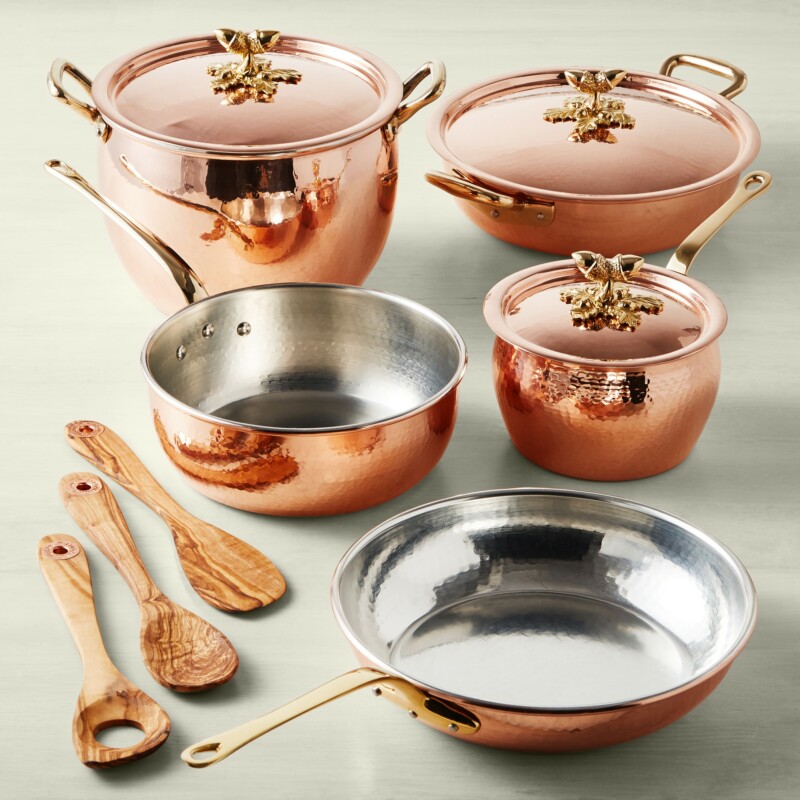
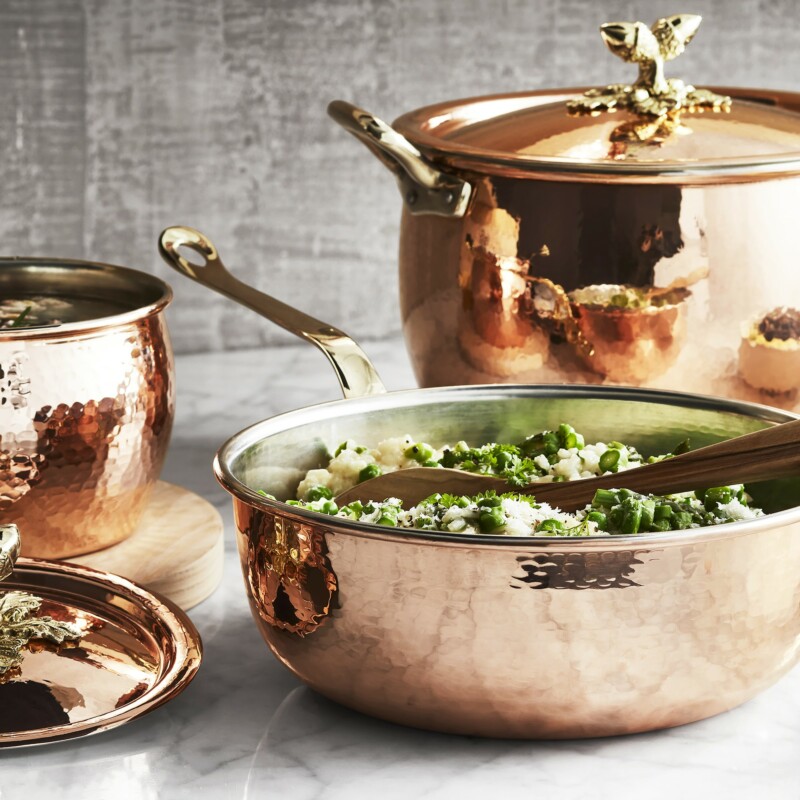
Carries: Pots, pans, roasters, kettles, bowls, and more
Price Range: $100 (small saucepan) – $1,600 (10-piece set)
One of the reasons Ruffoni gets our pick is because of how beautiful it is. I mean, one of the reasons you’re likely to choose copper cookware over another non-toxic alternative is because of the aesthetic, so why not choose the prettiest brand!?
Ruffoni has a few different collections which are either tin-lined or stainless steel-lined. (They also have an entirely stainless steel collection as well.) They use hammered copper for a textured look and add beautiful decorative knobs and other details.
Ruffoni is an Italian brand that has been around since 1931, and to this day, their pots and pans are still handcrafted by master coppersmiths at their family-owned workshop in the Italian Alps.
Just remember to keep a close eye on your lining and don’t use metal utensils while you cook to try and prevent scratching. You can learn more about Ruffoni’s re-tinning service here.
Other brands that carry copper cookware include:
Obviously, there are a lot of other cookware brands out there, so if there’s a specific one you’re wondering about, just let us know in the comments below and we’ll look into it!
And if you want to get more low-tox lifestyle guides, tips & trick, and more info sent to your inbox once a week, sign up for Filtered Fridays.





Hi! Do you guys have any recommendations for dinnerware? I am looking for a new set. Are brands like Lenox or Corelle safe?
Hi Kelly, we’re actually working on a dinnerware article right now, so stay tuned!